Although altered dominant chords are the most commonly altered chords, major and minor chords are frequently altered as well.
This post will cover how to construct some of the most common altered major and minor chords and provide examples for each type of chord.
It will also provide common fingerings for each chord, along with instruction on how to play them on a guitar with any root note.
Altered Major Chords
The most commonly altered major and minor chords are:
- Major seventh, flat five.
- Major seventh, sharp five.
- Major seventh, sharp eleven.
- Minor seventh, flat five.
- Minor seventh, sharp five.
- Minor, major seventh.
Major Seventh, Flat Five Chords
If we lower the fifth scale degree of a major seventh chord, it becomes a major seventh, flat five chord.
The chord formula for a major seventh, flat five chord is: 1, 3, b5, 7.
A major seventh, flat five chord contains the first, third, flatted fifth and seventh degrees of the major scale with the same root note:
- A Cmaj7(b5) chord contains the notes C, E, Gb and B — the first, third, flatted fifth and seventh notes in a C major scale (fig.1a).
- An Abmaj7(b5) chord contains the notes Ab, C, Ebb and G — the first, third, flatted fifth and seventh notes in an Ab major scale (fig.1b).
Fig.1

Major Seventh, Sharp Five Chords
If we raise the fifth scale degree of a major seventh chord, it becomes a major seventh, sharp five chord.
The chord formula for a major seventh, sharp five chord is: 1, 3, #5, 7.
A major seventh, sharp five chord contains the first, third, sharped fifth and seventh degrees of the major scale with the same root note:
- A Cmaj7(#5) chord contains the notes C, E, G# and B — the first, third, sharped fifth and seventh notes in a C major scale (fig.2a).
- An Abmaj7(#5) chord contains the notes Ab, C, E and G — the first, third, sharped fifth and seventh notes in an Ab major scale (fig.2b).
Fig.2

Major Seventh, Sharp Eleven Chords
If we add a sharped 11th scale degree to a major seventh chord, it becomes a major seventh, sharp eleven chord.
The chord formula for a major seventh, sharp eleven chord is: 1, 3, 5, 7, #11.
A major seventh, sharp eleven chord contains the first, third, fifth, seventh and sharped 11th degrees of the major scale with the same root note:
- A Cmaj7(#11) chord contains the notes C, E, G, B and F# — the first, third, fifth, seventh and sharped 11th notes in a C major scale (fig.3a).
- An Abmaj7(#11) chord contains the notes Ab, C, Eb, G and D — the first, third, fifth, seventh and sharped 11th notes in an Ab major scale (fig.3b).
Fig.3
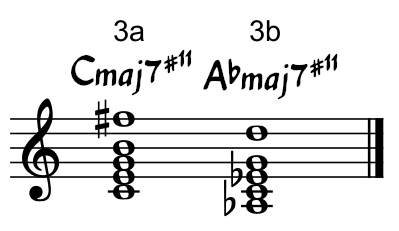
Altered Minor Chords
Minor Seventh, Flat Five Chords
If we lower the fifth scale degree of a minor seventh chord, it becomes a minor seventh, flat five chord.
The chord formula for a minor seventh, flat five chord is: 1, b3, b5, b7.
A minor seventh, flat five chord contains the first, flatted third, flatted fifth and flatted seventh degrees of the major scale with the same root note:
- A Cm7(b5) chord contains the notes C, Eb, Gb and Bb — the first, flatted third, flatted fifth and flatted seventh notes in a C major scale (fig.4a).
- An Abm7(b5) chord contains the notes Ab, Cb, Ebb and Gb — the first, flatted third, flatted fifth and flatted seventh notes in an Ab major scale (fig.4b).
Fig.4

Minor Seventh, Sharp Five Chords
If we raise the fifth scale degree of a minor seventh chord, it becomes a minor seventh, sharp five chord.
The chord formula for a minor seventh, sharp five chord is: 1, b3, #5, b7.
A minor seventh, sharp five chord contains the first, flatted third, sharped fifth and flatted seventh degrees of the major scale with the same root note:
- A Cm7(#5) chord contains the notes C, Eb, G# and Bb — the first, flatted third, sharped fifth and flatted seventh notes in a C major scale (fig.5a).
- An Abm7(#5) chord contains the notes Ab, Cb, E and Gb — the first, flatted third, sharped fifth and flatted seventh notes in an Ab major scale (fig.5b).
Fig.5
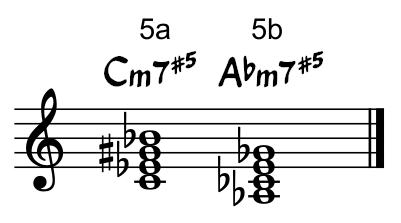
Minor, Major Seventh Chords
If we raise the seventh scale degree of a minor seventh chord, it becomes a minor, major seventh chord.
The chord formula for a minor, major seventh chord is: 1, b3, 5, 7.
A minor, major seventh chord contains the first, flatted third, fifth and seventh degrees of the major scale with the same root note:
- A CmM7 chord contains the notes C, Eb, G and B — the first, flatted third, fifth and seventh notes in a C major scale (fig.6a).
- An AbmM7 chord contains the notes Ab, Cb, Eb and G — the first, flatted third, fifth and seventh notes in an Ab major scale (fig.6b).
Fig.6

Summary of Altered Major and Minor Chord Formulas
The altered major and minor chord formulas covered in this post are summarized below:
- Major seventh, flat five: 1, 3, b5, 7.
- Major seventh, sharp five: 1, 3, #5, 7.
- Major seventh, sharp eleven: 1, 3, 5, 7, #11.
- Minor seventh, flat five: 1, b3, b5, b7.
- Minor seventh, sharp five: 1, b3, #5, b7.
- Minor, major seventh: 1, b3, 5, 7.
Omitted Notes
All of the notes in an altered chord formula don’t necessarily have to be included in any particular chord voicing. Some notes are less important than others and can be omitted.
The important notes that should always be included in an altered chord voicing are the chord’s third and seventh degrees, the highest extension note and any altered notes.
Root notes, the fifth scale degree and other extension notes are routinely left out of altered chord voicings on a guitar.
Altered Major Chords on a Guitar
Major Seventh, Flat Five Chords
Fig.7 shows a common fingering for a major seventh, flat five chord.
Fig.7

This fingering will allow you to play a major seventh, flat five chord with any root note:
- To play a Cmaj7(b5) chord, place your second finger on the C on the sixth string, eighth fret (fig.8a).
- To play an Abmaj7(b5) chord, place your second finger on the Ab on the sixth string, fourth fret (fig.8b).
Fig.8

Major Seventh, Sharp Five Chords
Fig.9 shows a common fingering for a major seventh, sharp five chord.
Fig.9
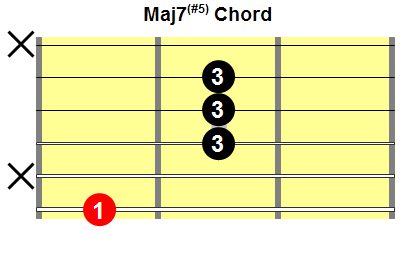
This fingering will allow you to play a major seventh, sharp five chord with any root note:
- To play a Cmaj7(#5) chord, place your first finger on the C on the sixth string, eighth fret (fig.10a).
- To play an Abmaj7(#5) chord, place your first finger on the Ab on the sixth string, fourth fret (fig.10b).
Fig.10
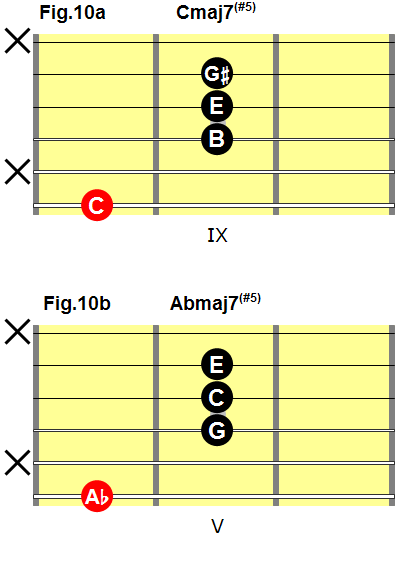
Major Seventh, Sharp Eleventh Chords
Fig.11 shows a common fingering for a major seventh, sharp eleven chord.
Fig.11
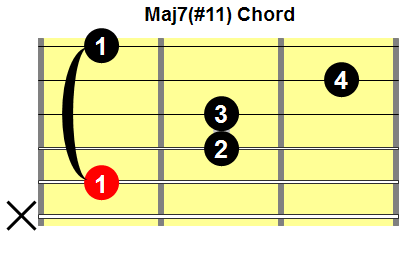
This fingering will allow you to play a major seventh, sharp eleven chord with any root note:
- To play a Cmaj7(#11) chord, place the barre on the third fret (fig.12a).
- To play an Abmaj7(#11) chord, place the barre on the 11th fret (fig.12b).
Fig.12

Altered Minor Chords on a Guitar
Minor Seventh, Flat Five Chords
Fig.13 shows a common fingering for a minor seventh, flat five chord.
Fig.13

This fingering will allow you to play a minor seventh, flat five chord with any root note:
- To play a Cm7(b5) chord, place the barre on the third fret (fig.14a).
- To play an Abm7(b5) chord, place the barre on the 11th fret fret (fig.14b).
Fig.14
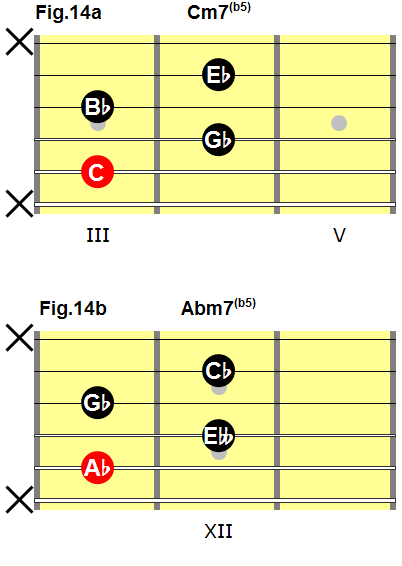
Minor Seventh, Sharp Five Chords
Fig.15 shows a common fingering for a minor seventh, sharp five chord.
Fig.15

This fingering will allow you to play a minor seventh, sharp five chord with any root note:
- To play a Cm7(#5) chord, place your second finger on the C on the sixth string, eighth fret (fig.16a).
- To play an Abm7(#5) chord, place your second finger on the Ab on the sixth string, fourth fret (fig.16b).
Fig.16

Minor, Major Seventh Chords
Fig.17 shows a common fingering for a minor, major seventh chord.
Fig.17

This fingering will allow you to play a minor, major seventh chord with any root note:
- To play a CmM7chord, place a barre on the eighth fret (fig.18a).
- To play an AbmM7 chord, place a barre on the fourth fret (fig.18b).
Fig.18
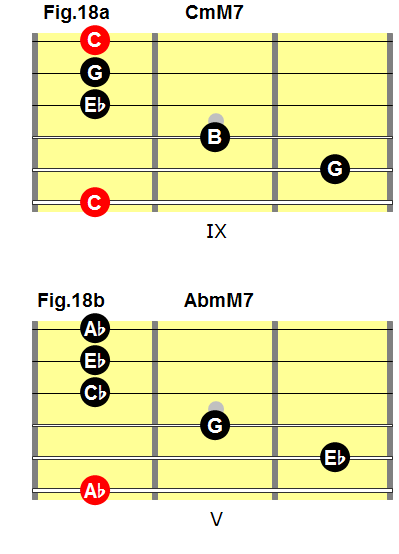
Related Posts
Related Posts include:
